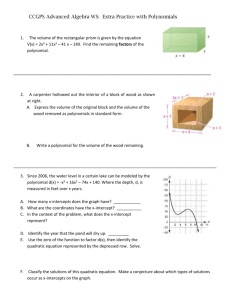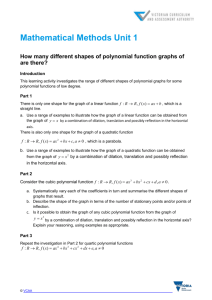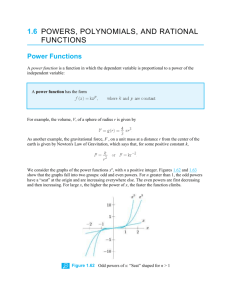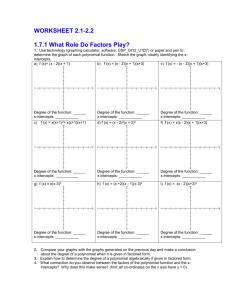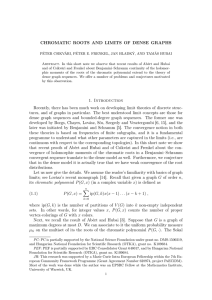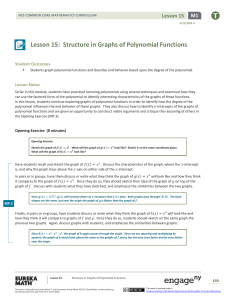Name Date 7.7 – Higher Degree Polynomials The shape of this
advertisement
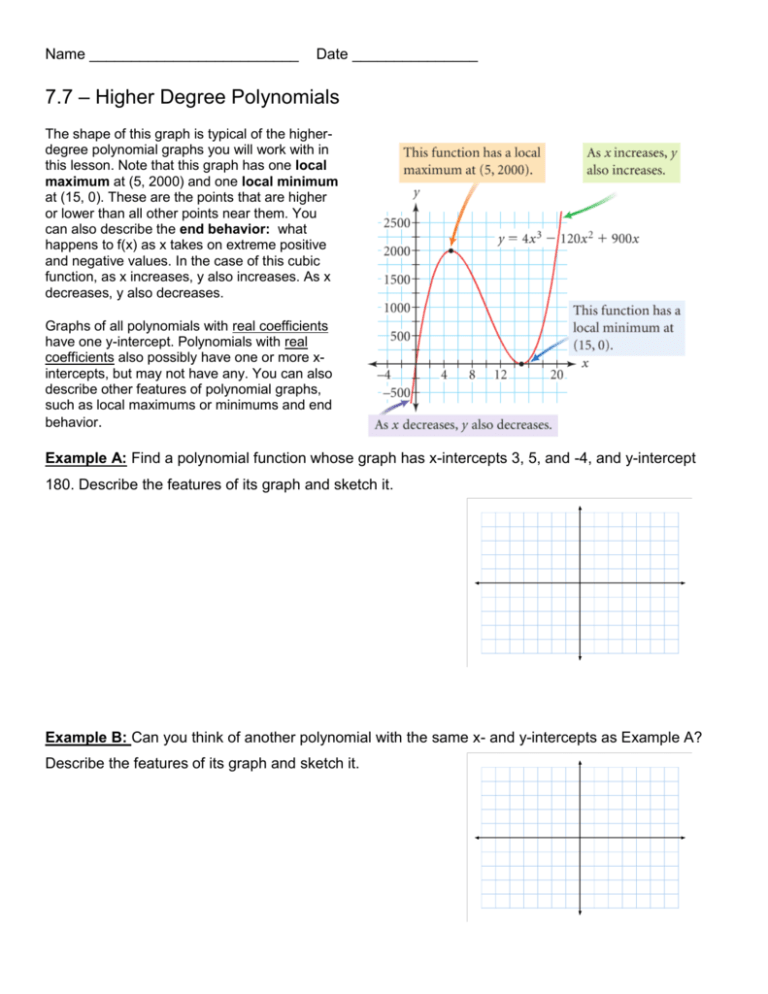
Name _________________________ Date _______________ 7.7 – Higher Degree Polynomials The shape of this graph is typical of the higherdegree polynomial graphs you will work with in this lesson. Note that this graph has one local maximum at (5, 2000) and one local minimum at (15, 0). These are the points that are higher or lower than all other points near them. You can also describe the end behavior: what happens to f(x) as x takes on extreme positive and negative values. In the case of this cubic function, as x increases, y also increases. As x decreases, y also decreases. Graphs of all polynomials with real coefficients have one y-intercept. Polynomials with real coefficients also possibly have one or more xintercepts, but may not have any. You can also describe other features of polynomial graphs, such as local maximums or minimums and end behavior. Example A: Find a polynomial function whose graph has x-intercepts 3, 5, and -4, and y-intercept 180. Describe the features of its graph and sketch it. Example B: Can you think of another polynomial with the same x- and y-intercepts as Example A? Describe the features of its graph and sketch it. You can identify the degree of many polynomial functions by looking at the shapes of their graphs. Every 3rd-degree polynomial function has essentially one of the shapes shown below. Graph A shows the graph of y x . It can be translated, stretched, or reflected. Graph B shows one 3 possible transformation of Graph A. Graphs C and D show the graphs of general cubic functions 3 2 in the form y ax bx cx d . In Graph C, a is positive, and in Graph D, a is negative. You’ll explore the general shapes and characteristics of other higher-degree polynomials in the investigation. Mini Investigation: The graph of y 2( x 3)( x 5)( x 4) has x-intercepts 3, 5, and -4 because they are the only 2 possible x-values that make y = 0. This is a 4th degree polynomial, but it has only three x-intercepts. The root x = -4 is called a double root because the factor (x + 4) occurs twice. a. Complete the missing table entries for polynomial functions ii-vi. Polynomial function Degree i. y 2( x 3)( x 5)( x 4)2 ii. y 2( x 3)2 ( x 5)( x 4) 4 Roots one at 3, one at 5, two at -4 iii. y 2( x 3)( x 5) ( x 4) 2 iv. v. two at 3, one at 5, two at -4 y 2( x 3)( x 5)( x 4)3 vi. y 2( x 3)( x 5) ( x 4) 2 3 b. Use your calculator to make a sketch of the general shape of each of the functions i-vi. Each graph should display all relevant features, including local extreme values. (You will need to change your window to see the entire graph shape.) i. y 2( x 3)( x 5)( x 4) 2 iv. ii. y 2( x 3) ( x 5)( x 4) iii. y 2( x 3)( x 5) ( x 4) v. y 2( x 3)( x 5)( x 4) vi. y 2( x 3)( x 5) ( x 4) 2 3 2 2 3 _______________________________ c. Based on your graphs and the table, describe the connection between the power of a factor and what happens at that x-intercept. Single Roots Double Roots Triple Roots Use what you learned about roots and sketch the general behavior of the following graphs. 1. y 2( x 2)2 ( x 1)( x 5)3 Degree: _________ Single Root: __________ Double Root: _________ Triple Root: __________ End Behavior: As x decreases, y _____________ As x increases, y ______________ 2. y 2( x 2)( x 1)2 ( x 4)2 Degree: _________ Single Root: __________ Double Root: _________ Triple Root: __________ End Behavior: As x decreases, y _____________ As x increases, y ______________ 3. y 5( x 1)( x 5)( x 4)3 Degree: _________ Single Root: __________ Double Root: _________ Triple Root: __________ End Behavior: As x decreases, y _____________ As x increases, y ______________



